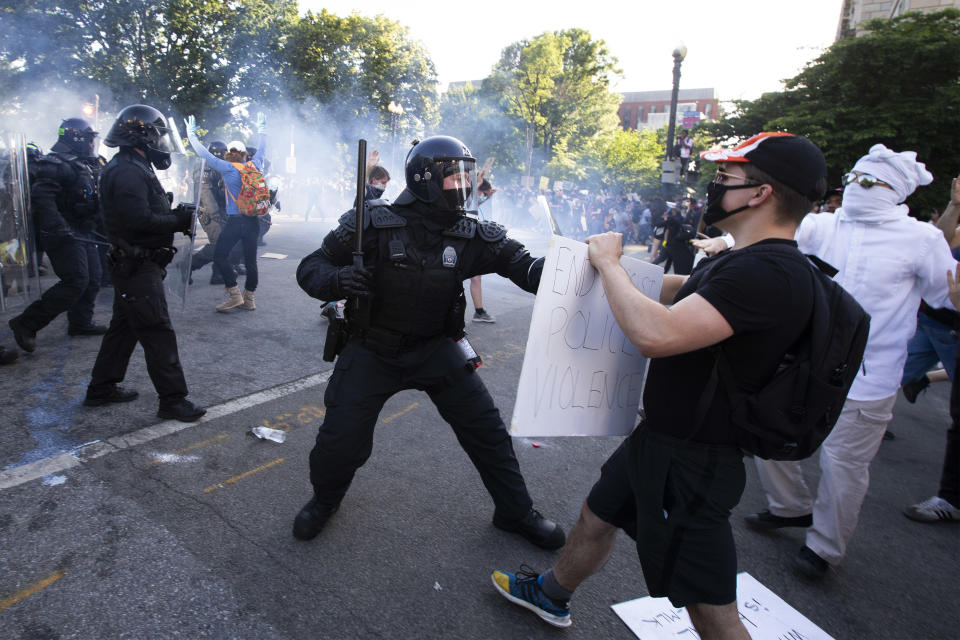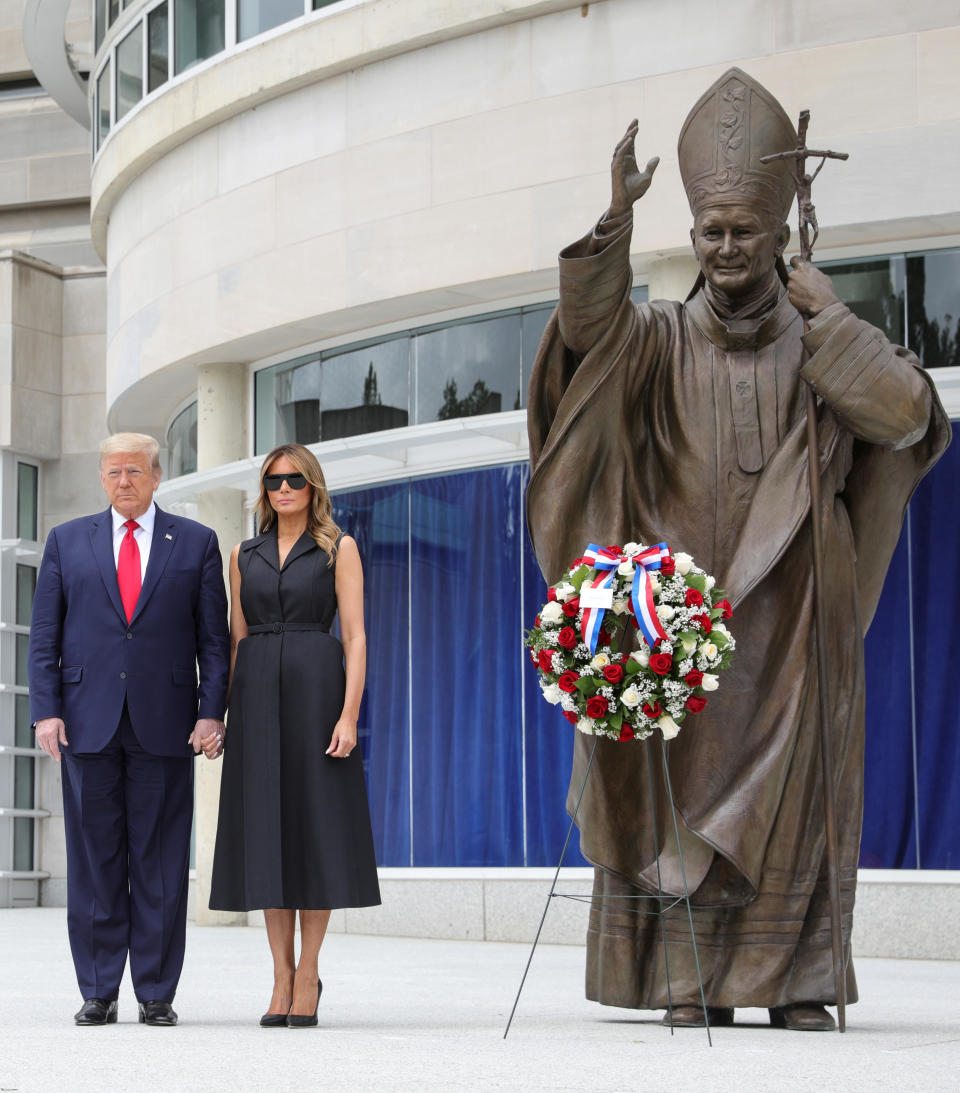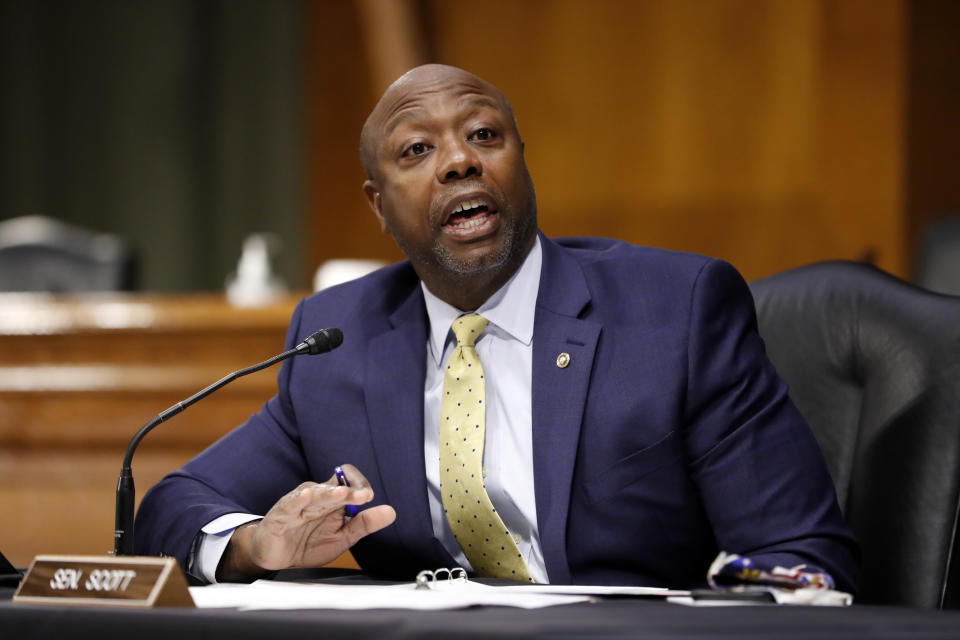Religious leaders condemn teargassing protesters to clear street for Trump
Religious leaders around the country are condemning the use of tear gas on peaceful protesters outside the White House Monday evening to clear the area for President Trump to walk across the street to be photographed in front of a church.
St. John’s Church was damaged by fire during demonstrations over the death of George Floyd in police custody in Minneapolis. Reports indicated that the fire was mostly in the basement of the church and did not seriously damage the sanctuary.
“The President of the United States stood in front of St. John’s Episcopal Church, lifted up a bible, and had pictures of himself taken,” Bishop Michael Curry said in a statement. “In so doing, he used a church building and the Holy Bible for partisan political purposes. This was done in a time of deep hurt and pain in our country, and his action did nothing to help us or to heal us.”

In a hastily delivered statement from the Rose Garden on Monday, Trump vowed to use the military to put an end to violence and looting that has marred protests in several cities. As he spoke, Washington, D.C., police and the National Guard used tear gas and rubber bullets to clear Lafayette Square (located between the White House and the church) and the surrounding area. On Tuesday afternoon, the Washington Post reported that Attorney General William Barr had personally ordered the area around the church cleared.
At least one Episcopal priest was among those teargassed.
The Rev. Gini Gerbasi told Religion News Service that she was on the church’s patio when she and a seminarian were teargassed by police in riot gear.
“I’m there in my little pink sweater in my collar, my gray hair up in a ponytail, my reading glasses on. … I was suddenly coughing from the tear gas,” Gerbasi said.
Trump and White House aides walked across the street to the church, where Trump posed for photos holding a Bible. When asked by reporters if it was his Bible, Trump said it was “a Bible.”
Outrage over Trump’s photo op transcended faiths.
“Seeing President Trump stand in front of St. John’s Episcopal Church while holding a Bible in response to calls for racial justice — right after using military force to clear peaceful protesters out of the area — is one of the most flagrant misuses of religion I have ever seen,” Rabbi Jack Moline, president of Interfaith Alliance, said in a statement Monday. “This only underscores the president's complete lack of compassion for Black Americans and the lethal consequences of racism.”

“Using the Bible as a prop while talking about sending in the military, bragging about how your country is the greatest in the world, and publicly mocking people on a daily basis, is pretty much the opposite of all Jesus stood for,” Rev. James Martin, a prominent Jesuit priest and author, said in a statement to NBC News. “Let me be clear. This is revolting. The Bible is not a prop. A church is not a photo op. Religion is not a political tool. And God is not a plaything.”
“Not only was this manipulative,” Bishop Elizabeth Eaton, head of the Evangelical Lutheran Church of America, said on Twitter, “it was desecration.”
Bishop Mariann Budde, leader of the Episcopal Diocese of Washington, D.C., said she was not informed of the president’s visit ahead of time, and learned about it from watching it on television.
“I am outraged,” Budde said in a statement. “The president did not pray when he came to St. John’s; nor did he acknowledge the agony and sacred worth of people of color in our nation who rightfully demand an end to 400 years of systemic racism and white supremacy in our country.”
Some members of the religious right, including Faith and Freedom Coalition chairman Ralph Reed and Dallas megachurch pastor Robert Jeffress, defended the president.
“I thought it was completely appropriate for the president to stand in front of that church,” Jeffress told the Atlantic. “And by holding up the Bible, he was showing us that it teaches that, yes, God hates racism, it’s despicable — but God also hates lawlessness.”
White House counselor Kellyanne Conway also defended Trump in a Tuesday interview with Fox News.
“That is not ‘her church,’ that is not ‘her Bible,’” Conway said of Budde. “We don’t look into other people’s hearts and souls and discern and judge what their faith is.”
In 2011, Trump told Fox News, falsely, that President Obama “doesn’t have a birth certificate. He may have one, but there's something on that, maybe religion, maybe it says he is a Muslim.”
On Tuesday, Trump visited the Saint John Paul II National Shrine in Washington, D.C., drawing protesters and criticism from a number of Catholic leaders.

“I find it baffling and reprehensible that any Catholic facility would allow itself to be so egregiously missed and manipulated in a fashion that violates our religious principles, which call us to defend the rights of all people, even those with whom we might disagree,” said Archbishop Wilton Gregory, the country’s only archbishop, in a statement. “Saint Pope John Paul II was an ardent defender of the rights and dignity of human beings. His legacy bears vivid witness to that truth. He certainly would not condone the use of tear gas and other deterrents to silence, scatter and intimidate them for a photo opportunity in front of a place of worship and peace.”
The shrine is run by the Knights of Columbus, not the Washington archdiocese. In a statement to the Washington Post, the shrine said that the White House originally scheduled the visit as an event for the president to sign an executive order on international religious freedom. Trump did not make any remarks during his visit there with first lady Melania Trump.
Sister Simone Campbell, executive director of the Catholic advocacy group Network, said Trump was “using the Catholic faith in another photo op to defend his appalling refusal to address racism and police violence in the United States.”
“He is trying to create a false dichotomy of peaceful protesters versus the Church,” Campbell added. “That could not be further from the truth, and any Christian who believes it does not understand Jesus’s message.”
GOP mostly silent on Capitol Hill
A few Republican senators offered cautious criticisms of Trump’s photo op on Monday. Sen. Tim Scott of South Carolina, the only black Republican U.S. senator, told Politico that he hadn’t seen the incident, “but obviously, if your question is, should you use tear gas to clear a path so the president can go have a photo op, the answer is no.” Sen. Ben Sasse of Nebraska said he was “against clearing out a peaceful protest for a photo op that treats the Word of God as a political prop.”

Sen. Susan Collins of Maine, facing a tough reelection fight in November, said,”It was painful to watch peaceful protesters be subjected to tear gas in order for the president to go across the street to a church that I believe he’s attended only once. I thought that the president came across as unsympathetic and as insensitive to the rights of people to peaceful protest.”
Other senators besides Scott said they had missed the attack on peaceful protesters that was carried live on television and replayed on social media repeatedly. NBC News correspondent Kasie Hunt asked a number of GOP senators for their responses and collected them on Twitter.
“Didn’t really see it,” said Sen. Ron Johnson of Wisconsin, while Sen. Steve Daines of Montana said he “was grateful for the president’s leadership.”
Sen. Pat Roberts of Kansas said he had no comment, while Sen. Mitt Romney of Utah, who has been relatively outspoken against Trump, said, “I didn’t watch it closely enough to know.”
Sen. Bill Cassidy of Louisiana said, “I didn’t follow, I’m sorry,” while Sen. Josh Hawley of Missouri said he had seen “conflicting reports” of what happened at the White House. Sen. Rob Portman of Ohio and Sen. Mike Enzi of Wyoming declined to comment because they were late for lunch.
Sen. Ted Cruz of Texas, when asked if the attack was an abuse of power, said it was: by the protesters.
_____
Click here for the latest coronavirus news and updates. According to experts, people over 60 and those who are immunocompromised continue to be the most at risk. If you have questions, please refer to the CDC’s and WHO’s resource guides.
Read more:


